PANEL ZERO (1)
By:
January 18, 2018
Being the first in a new monthly series of deep-cutting, far-drifting discussions on the comicbook artform and its cultural influences, expressive aspirations and unintended consequences.
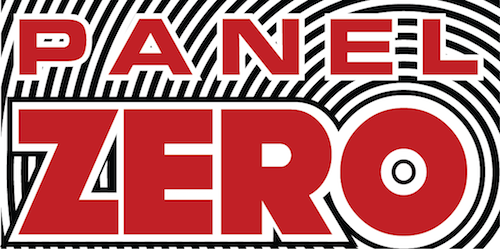
We’re not Number One, but every American thinks they can be. A paradox, you would think, but what’s more important is how we feel, and with an actual casino-owner now in power, maybe every number can be One.
Even before 2016, though, we’d try to gather up all the vicarious Firsts we could — original editions of comicbooks; limited printings of stamps or money; our favorite winning team. George Washington, of course, was our actual No. 1 president, appears on the 1-unit cornerstone of our currency, and won the conflict that started the clock on our country. And now he’s got a first-edition comicbook too.
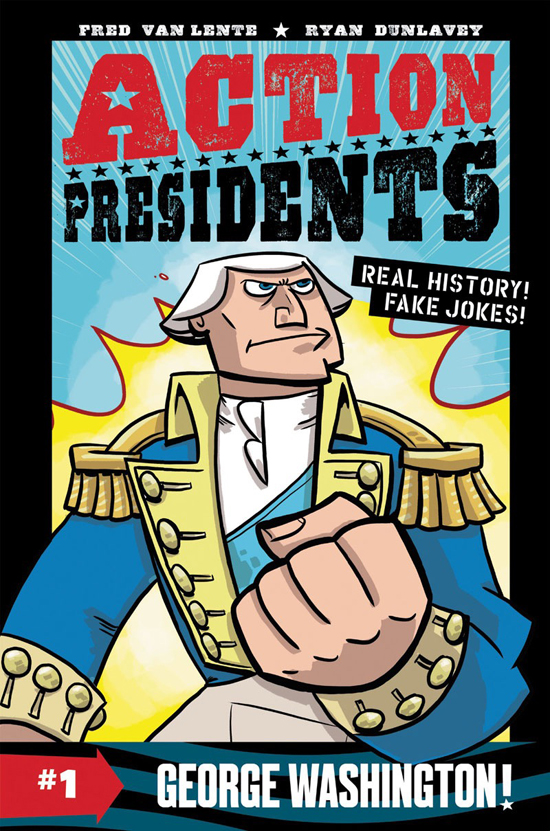
The graphic novel series Action Presidents begins with its George Washington volume, written and drawn by Fred Van Lente and Ryan Dunlavey, auteurs of the Aughts indie-comic sensation of shop, school and library shelf, Action Philosophers.
Like its predecessor, Action Presidents is a kind of History for Dummies that’s only playing dumb, taking the mischievous comedic tack that causes you not to accept myths at face value, and employing the memorable wit that makes facts stick. Originally planned as a comic series on the Philosophers model, Presidents got picked up by HarperCollins as a set of book-length histories instead.
I google-hungout with Van Lente and Dunlavey to talk about what we can expect from the past, the role of cartoon animals in cultural preservation, and why we won’t be seeing Chester A. Arthur anytime soon…
HILOBROW: The visual humor hits a new level of cleverness and coordination with this book; how much of that do you riff yourself, and how much is set out by Fred in his scripts?
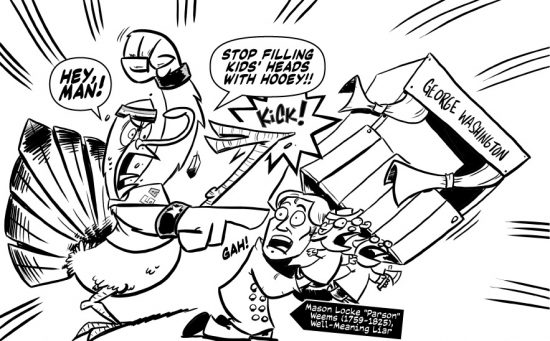
DUNLAVEY: There’s plenty of room, I just try to bring as much of my own sense of humor and personality to it as I can. Fred’s stuff is really funny, and I’m always just trying to top him [laughs]. Another thing is, I do my own research as well into everybody that’s featured in the book, independently of Fred, and try to first form my own opinion about what all these characters were like, and that comes through in the drawing. If I think, “Oh, this guy was an idiot,” I’m gonna draw him as an idiot; if he was arrogant, I’m gonna draw him arrogant.
I did that with the main character designs; in Fred’s script and also my own perception, George Washington I thought was a big, larger-than-life, almost a superhero character, and so the whole time I was drawing him, I had in mind, like, a Bruce Timm cartoon. With Lincoln, I thought of him as an awkward person in an awkward situation so I thought of like a Don Martin cartoon. And Teddy Roosevelt, he’s totally a Jack Kirby character. He looks very cocky and bombastic.
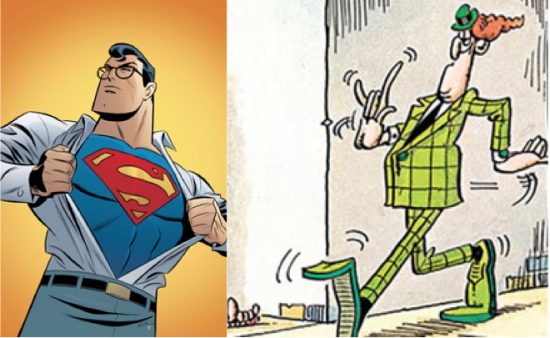
HILOBROW: Your storytelling feels to me like it’s in motion, almost as if your drawing is based even more in animation than in comics.
DUNLAVEY: A lot of it is having the freedom to do a 120-page story instead of the usual 10-or-less. The story of George Washington’s first expedition was 7 or 8 pages here; in our traditional style it probably would have had to be one or two panels. It helped having more space, which I do like doing quite a bit.
HILOBROW: Was the original shorter version [a limited-run single-issue-length comicbook] boiled down from this, or was this expanded from it?
DUNLAVEY: It was completely redone. I didn’t copy-and-paste any panels. Just because there’s different storytelling problems when you’re doing 120 pages versus 20.
[At this point Fred joins the hangout, and adds to the historical record of the George Washington bio’s two beginnings:]
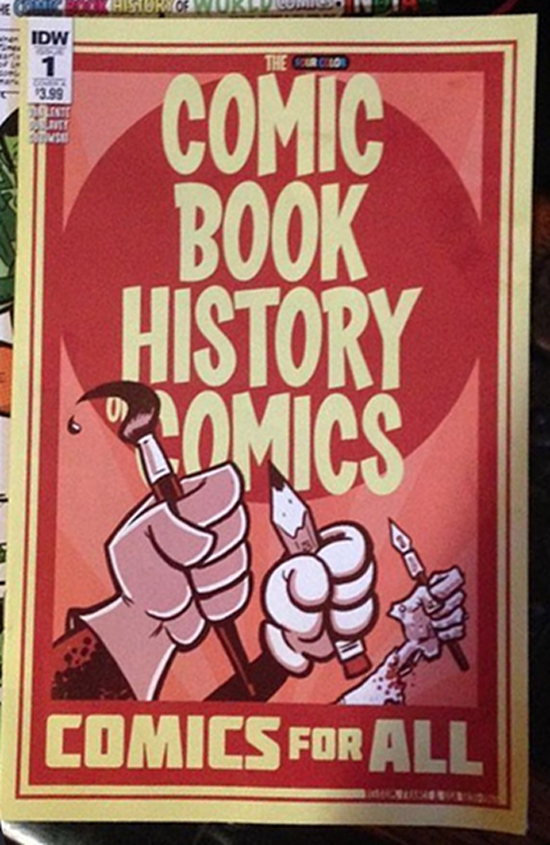
VAN LENTE: This project has gone on for, like… ever [laughs]. We came up with it at the same time we came up with The Comic Book History of Comics [the team’s nonfiction series between Action sequences, aka Comic Book Comics, in 2008], didn’t really do anything with it until [visual educator] Josh Elder started putting together his textbook Reading with Pictures, and hired us to do a story, so we’re like, “Well, here’s an opportunity to do a proof-of-concept of Action Presidents and get paid for it.”
Then that took forever to come out, as is the nature of Kickstarter projects. And then Ryan, you did that print-run of just that story, and then we got an agent, and then I wrote the proposal, and then Jason our agent went to a bunch of publishing houses and got a lot of interest, then we finally signed with HarperCollins and then I had to write a script. So by the time I actually did the second version, I had forgotten there was a first version. [laughs] So, there’s elements and panel ideas that are the same, but the thrust of it is a lot different. The original story was more about debunking myths about American history generally, and while there’s some of that in the final book, it’s nowhere near the focus.
DUNLAVEY: While I was drawing this, Fred actually had forgotten he also wrote a second issue, in the old 20-page format; I have a John Adams script that’s still undrawn.
VAN LENTE: And there’s a Chester Arthur script…
HILOBROW: That’s an interesting choice, since Chester Arthur is probably not on anyone’s list of the top 10 presidents for a dramatic treatment. So, even though you were planning on doing all 45 (or 43, when this started), you were scripting the stories out of sequence?
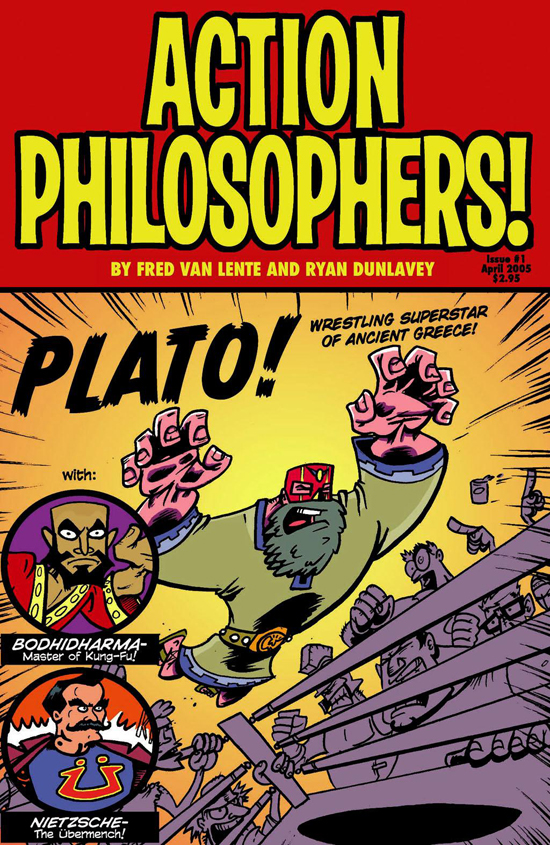
VAN LENTE: If you’ll recall, the way Action Philosophers was originally “structured” [laughs] was, random philosophers thrown together under a basic theme, and we were gonna do Action Presidents the same way. The first issue was going to be about… “Assassination Encores,” all the ones who became president as a result of their predecessor being killed! Lyndon Johnson, Chester Arthur… Chester Arthur of course became president following Garfield’s assassination — and was the only president to actually be accused of engineering his predecessor’s murder, which sort of makes him unique and interesting. Well, maybe not interesting…certainly to me. [laughs] But then… we were originally gonna do Comic Book Comics and Action Presidents at the same time, ha ha, and once it became clear [we couldn’t], I set that script aside.
When we pitched it to HarperCollins we pitched it as a series of structured books, not individual presidents, but, for some reason HarperCollins wants to make money [laughs], so… they made us focus on the famous ones. We pitched it as doing all the presidents in six or so books, and they countered with one president per book. One other company who shall go nameless said, “This is great, why don’t you guys do scientists!” So I wrote a whole script for Action Scientists, but they gave us a stupefyingly miniscule budget, so we had to turn that down, based on…
DUNLAVEY: Reality. [laughter]
HILOBROW: So did Harper suggest the playlist, so to speak?
VAN LENTE: They did…
DUNLAVEY: We each had our favorites. Lincoln and Washington were definitely going to happen.
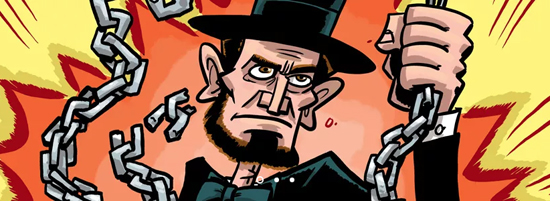
VAN LENTE: It was the other two that we went back and forth on, until we finally landed on Roosevelt and JFK. They always wanted JFK, they love JFK. I don’t think 5th graders really give a crap about JFK? [laughs] But the adults who buy and market and edit books do. So, you’re getting a JFK book, congratulations.
DUNLAVEY: It’s good!
VAN LENTE: It’s going to be very good.
DUNLAVEY: Well, let’s see how the artwork comes out.
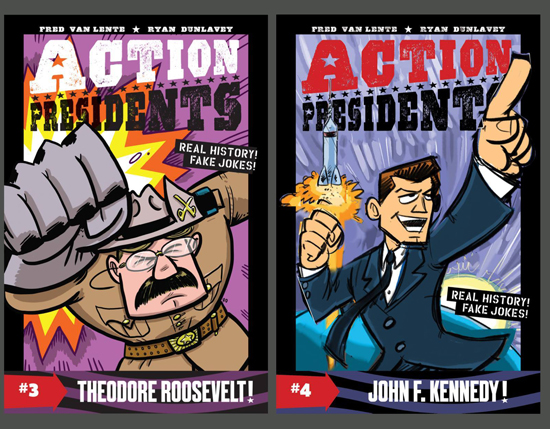
HILOBROW: But from you guys’ point of view, there’s probably no president whose story couldn’t make a good read, if you pay enough attention and know enough about the background?
VAN LENTE: Definitely. If you can make Chester Arthur interesting [laughs] you can make Rutherford B. Hayes interesting.
HILOBROW: I hadn’t even known about Arthur being accused of Garfield’s murder; that’s an amazing story right there.
VAN LENTE: Well, he was accused by the actual murderer [laughter], so it was not, y’know, from a credible source. My favorite fact about the guy who killed Garfield is that he was so unpleasant he went to a “free love” colony and couldn’t get laid.
HILOBROW: I did not know that either. Just like I only learned about Adam West being thrown out of an orgy from your Comic Book History of Comics!
VAN LENTE: Read Back to the Batcave, you’ll learn more about Adam West’s sex life than you ever wanted to.
HILOBROW: Hmm, it’s like you’re giving me a reverse reading-list.
DUNLAVEY: [laughs] We’re encouraging illiteracy!
VAN LENTE: Don’t blame me, blame Adam West.
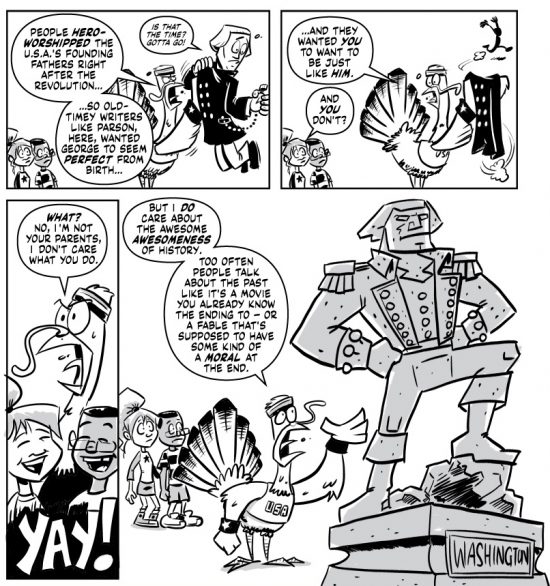
HILOBROW: Ryan was saying that, to get a fix on George Washington’s personality visually, he thought of Bruce Timm’s Superman, which is funny since I’d been thinking that Washington is like the Superman of American historical figures — so essential he seems to paradoxically fade into the background. Fred, was it a challenge to not just bring him down to human scale him but also make him seem like more than a symbol, a name on a building or a statue?
VAN LENTE: It’s a side-effect of putting something into a narrative that you end up putting some kind of a gloss on it; it’s what gives the narrative structure as opposed to just a list of facts. But I try not to have an agenda beyond what the facts imply. Let water find its own path. The challenge, from the public, when you’re doing history, is that everyone wants the history to be either hagiography or the opposite; some people want everything to be “America, YES” or “America, FUCK YOU”; there’s always an agenda, it always has to be either the Founding Fathers were blameless gods, or they were irredeemable scum.
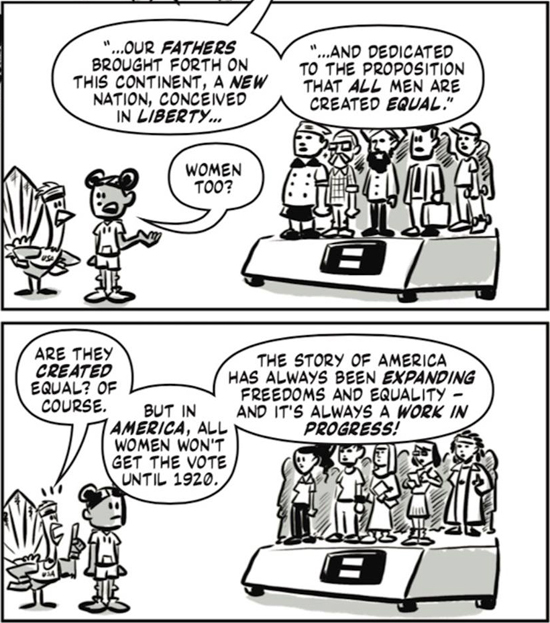
HILOBROW: I thought this book struck a rare balance, presenting the principles fought for, the slaves not released, etc., for the reader to weigh. Whatever the spin (or no-spin), though, the Revolutionary period seems to remain the one least covered in American pop culture, with a few generational exceptions like the 1776 and Hamilton musicals. Is there something about this period that calls for special sweetening with entertainment, like those shows’ song-and-dance or your book’s comedy?
VAN LENTE: Very true [about the era’s relative unpopularity]; I love this period and I’m kind of addicted to it, so I’ve read about it off and on my whole life. For whatever reason the genre of the Western has been bigger… I just think it’s slavery. [laughter] We’ll just apply Occam’s razor to this. There’s a reason why the most popular historical genre in American history takes place right after the Civil War. ’Cuz then we don’t have to talk about that. You’re put in an uncomfortable position — unless you’re like Mel Gibson doing The Patriot where all his slaves are super happy and down with The Mel — you’re put in a position of having heroes who own slaves. As many if not most of the Founding Fathers did. For a lot of people, that’s a bridge too far. People don’t wanna remember that there were Americans who… in a slave-owning society, you’re dealing either with heroes who were slave-owners, which is problematic, or heroes who were slaves, which is also problematic, so people are like, “Fuck it, let’s put on Star Wars again [laughs] — now we have a much clearer idea of who’s good and who’s evil.”
HILOBROW: Or be like Tarantino and give the slaves guns.
VAN LENTE: And Django itself, even though it’s technically a “Southern,” it’s a Western, it has all the tropes.
HILOBROW: True — it’s almost like the “acceptable” genre is invading and avenging the antebellum fantasy. Maybe related to that, it seems like a lot of what Colonial pop is out there tends to focus more on everyday people than on the historical figures — maybe people who would be too poor to own slaves, in fictions like Johnny Tremain.
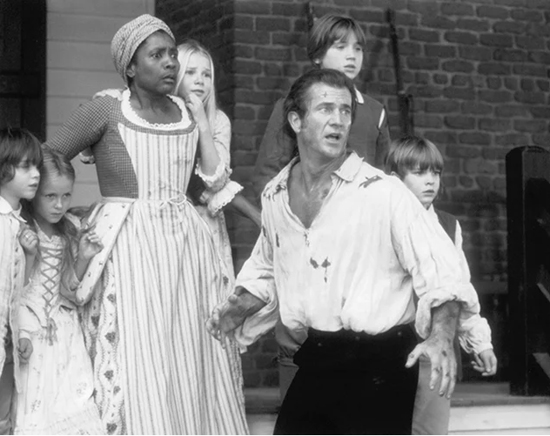
VAN LENTE: It’s possible. What’s fascinating is that even most of the Civil War fiction is about, “Oh, it’s brother against brother, how did we come to this, I don’t know!!” [laughter] “We had to fight for some reason, it’s so tragic.” It’s hilarious because there you have what to me is a fairly straightforward moral conflict that gets muddied, while it’s almost like the American Revolution is too morally ambiguous to really sustain pop culture. Beyond, ya know… I was in Disney World just this past weekend? And there’s a whole section called Liberty Square which is like the “Rah-Rah, America Fuck Yeah” part of Disney World. I was sorta fascinated ’cuz it’s like this pseudo Colonial Williamsburg, and then my wife and I went and saw the Hall of Presidents show, and it was packed — I mean, I’m worried about Country Bear Jamboree, guys [laughter], I love me some robot bears.
I had to look on the Disney website, and it’s a 700-seat theatre, and it was standing-room only. It was nuts. I assume part of it is the grotesqueness of Robo-Trump that’s making waves on social media, but I also think there’s a hunger for this simple kind of Americana. You get this short film on history that, if you were an alien from outer space or dropped out in the second grade, that level of American history, then the screen comes up and there’s 45 robots standing there. Mostly it’s a roll-call, they nod as their names are said; Lincoln gives the Gettysburg Address and Washington gives this fairly boilerplate speech about what a great responsibility it is, and then Trump speaks and basically about six people in the audience started clapping really loudly, and the other 690 people just kinda sat there in silence. And Robo-Trump is way more articulate than the flesh version.
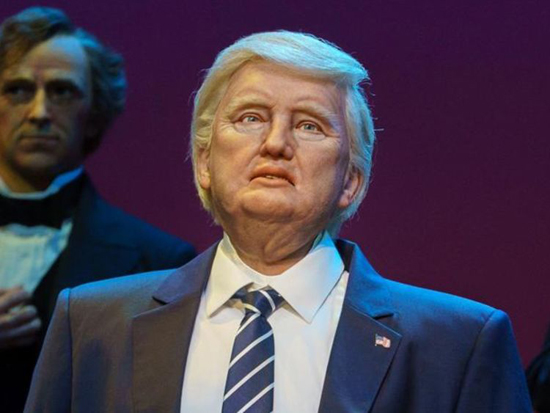
HILOBROW: Do you think there’s any element of people wanting to understand, or compare interpretations, rather than just have a simplified, roboticized experience of history?
VAN LENTE: It’s a very fraught time in the country so I think people are looking to things like that to affirm whatever their version of America is. The Trumpies are going to cheer on Robo-Trump, and a lot of people are going to see some kind of genuine version of America affirmed. I was really surprised it was such a huge draw — it was also crawling with… well, they’re dressed like cops, but they have the mouse-ears on their patches, so it was like some grotesque Simpsons parody of Disney World. Though I guess they have a lot of genuine presidential artifacts in the lobby. It was kinda nuts.
HILOBROW: I love Noah the Historkey [Action Presidents’ host/narrator, pardoned at Thanksgiving on a kind of work-release to educate kids like the two that George Washington’s life is retold to]. It got me thinking how often kids’ lit has this kind of spirit-guide. Is it just a narrative device, or more of a mentor figure to give kids, one who can navigate the truths of the world while not shaming them for what they don’t know?
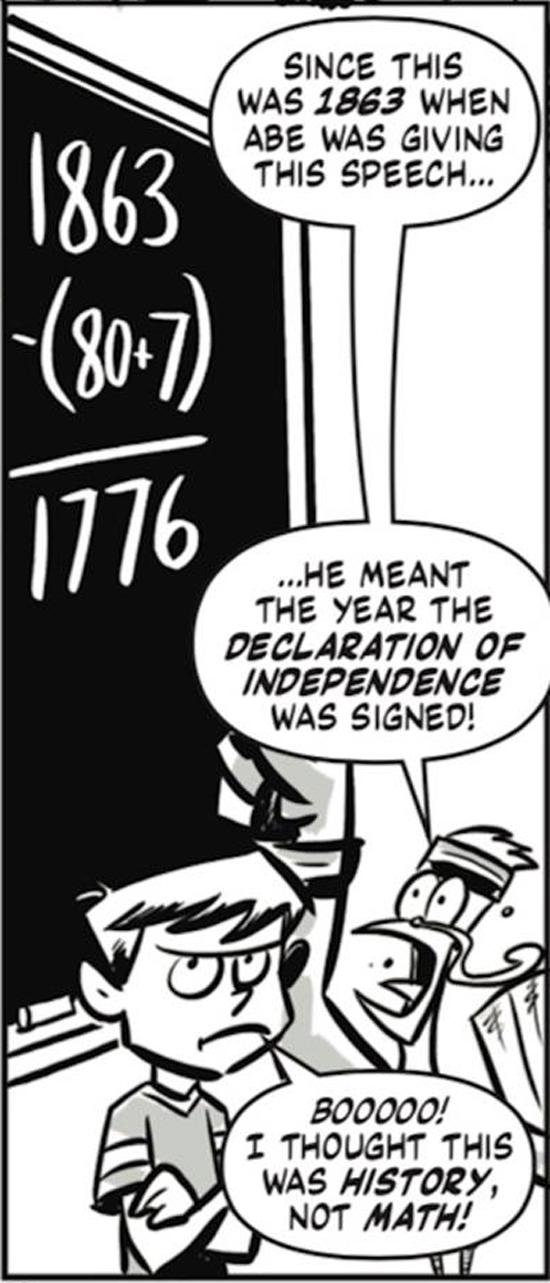
DUNLAVEY: My favorite thing about Noah is that Fred has him yell at the kids, constantly. [laughter]
VAN LENTE: That’s true. He’s a crank. More of a Donald Duck figure than a Mickey Mouse.
DUNLAVEY: He’s a Mary Sue for Fred, really.
VAN LENTE: Yes, he’s expressing my inner opinion about children. [laughter] I think kids kinda get off on that, they like being yelled at by cartoon animals.
DUNLAVEY: My kids have really dug it, they’ve seen the proofs and they keep asking me to draw the stupid turkey, so he might be a hit! [My son] has actually written fan fiction about Noah the Historkey, so brace yourself, there could be more.
VAN LENTE: I like it, post that stuff! I’ve always hated… [assumes pontificating voice] Ryan and I, being pioneers in the field of nonfiction comics, have, as always, seen lesser imitators crowd the field, and annoy the shit out of us. [laughter] And the common theme among all of them… I think it’s because some people have only read Scott McCloud’s Understanding Comics; if [it’s] not their only comic, then at least their only nonfiction comic, so everybody needs a narrator character. Which I have resisted in our comics for years, but, in a moment of weakness, since this is our first big, mainstream release, I was like, fuck it, we’re just gonna do it.
DUNLAVEY: Better a turkey than ourselves.
Action Presidents Volumes 1 (George Washington) and 2 (Abraham Lincoln) each debut on February 7, 2018 from HarperCollins.
Panel Zero logo designed by Steve Price
MORE COMICS-RELATED SERIES: Douglas Wolk’s LIMERICKANIA | KIRB YOUR ENTHUSIASM — 25 writers on 25 Jack Kirby panels | ANNOTATED GIF — Kerry Callen brings comic book covers to life | COMICALLY VINTAGE — that’s-what-she-said vintage comic panels | DC — THE NEW 52 — an 11-year-old reviews DC’s new lineup | SECRET PANEL — Silver Age comics’ double entendres | SKRULLICISM — they lurk among us | Douglas Wolk’s THAT’S GREAT MARVEL, TAKING LIBERTIES, STERANKOISMS, MARVEL vs. MUSEUM, LIMERICKANIA, WTC WTF
MORE POSTS by ADAM McGOVERN: OFF-TOPIC (2019–2025 monthly) | textshow (2018 quarterly) | PANEL ZERO (comics-related Q&As, 2018 monthly) | THIS: (2016–2017 weekly) | PEOPLE YOU MEET IN HELL, a 5-part series about characters in McGovern’s and Paolo Leandri’s comic Nightworld | Two IDORU JONES comics by McGovern and Paolo Leandri | BOWIEOLOGY: Celebrating 50 years of Bowie | ODD ABSURDUM: How Felix invented the 21st century self | CROM YOUR ENTHUSIASM: C.L. Moore’s JIREL OF JOIRY stories | KERN YOUR ENTHUSIASM: Data 70 | HERC YOUR ENTHUSIASM: “Freedom” | KIRK YOUR ENTHUSIASM: Captain Camelot | KIRB YOUR ENTHUSIASM: Full Fathom Five | A 5-part series on Jack Kirby’s Fourth World mythos | Reviews of Annie Nocenti’s comics Katana, Catwoman, Klarion, and Green Arrow | The curated series FANCHILD | To see all of Adam’s posts, including HiLo Hero items on Lilli Carré, Judy Garland, Wally Wood, and others: CLICK HERE
